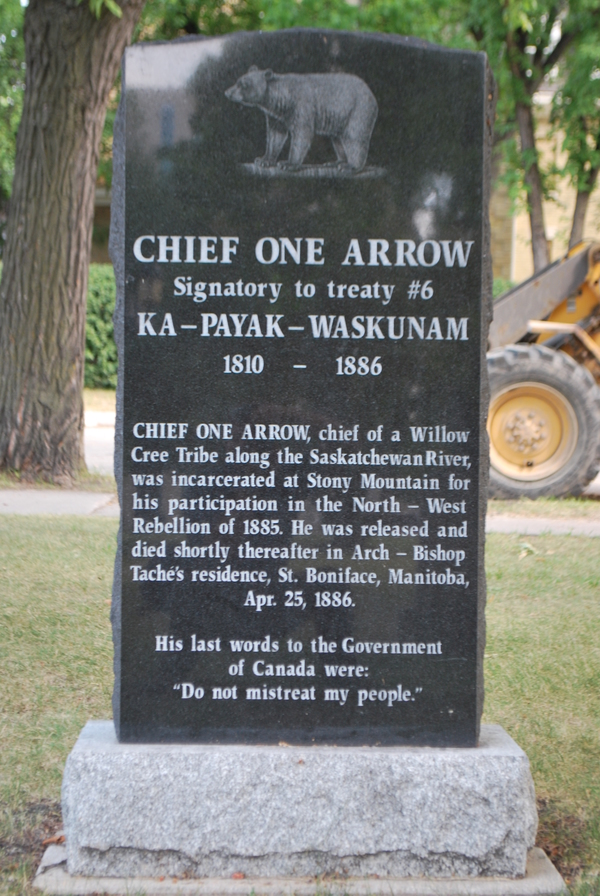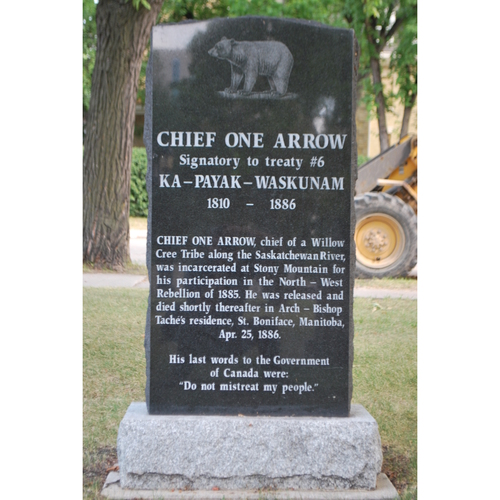
Source: Courtesy of Wikimedia Commons
KĀPEYAKWĀSKONAM (Kah-pah-yak-as-to-cum, One Arrow, known in French as Une Flèche), chief of a band of Willow Crees, b. c. 1815 probably in or near the valley of the Saskatchewan River; d. 25 April 1886 at St Boniface, Man.
One Arrow was the chief of a band of Willow Crees which, until the disappearance of the buffalo from the Canadian prairies in the 1870s, traditionally hunted in the region bisected by the South Saskatchewan River and stretching from near Duck Lake in the north to Little Manitou Lake and Goose Lake to the southeast and southwest respectively. After a last desperate trek to the Cypress Hills in search of bison in 1879, the great majority of the band settled permanently on their reserve four miles east of the South Saskatchewan River, behind the Métis settlement of Batoche (Sask.). After the 16-square-mile site was surveyed in 1881, the hunting operations of the band appear to have shifted to the east, into the wooded and parkland areas of the Carrot River valley where small game could still be found.
One Arrow’s followers did not initially impress the officials of the Department of Indian Affairs with their efforts towards agricultural self-sufficiency, but the department also took little notice of the fact that, as late as 1884, the band had not received from the government many of the implements and some of the livestock which it had been promised in 1876 under the terms of Treaty no.6. Nor did it receive, until 1884, the instruction and supervision in farming given to most other bands; once it was begun, the band made rapid progress.
Chief One Arrow himself did not come into prominence until the outbreak in 1885 of the North-West rebellion. In 1876 he had been associated with chiefs Beardy [Kamīyistowesit] and Saswaypew (Cut Nose) in an attempt to obstruct the negotiation of Treaty no.6 at Fort Carlton (Sask.), but on 28 August, five days after the treaty had been concluded, One Arrow and the other two chiefs signed a formal adhesion to the agreement. In 1880 the same three chiefs were arrested on a charge of inciting their followers to butcher government cattle. A jury refused to convict them, however, much to the disgust of the officials of the Department of Indian Affairs. Four years later, in August 1884, One Arrow attended a large council of chiefs along with Big Bear [Mistahimaskwa] and Papewes* (Papaway, Lucky Man) to discuss Indian grievances. He seems to have joined in the charges that the “sweet promises” made at the time of the treaty, “in order to get their country from them,” had not been kept, and in the threats of unspecified but non-violent measures that would be taken in order to force the government to act. In all of these activities, however, One Arrow does not seem to have played more than a minor role.
His part in the North-West rebellion is, in many respects, unclear. Since his reserve was the closest to the Métis settlement on the South Saskatchewan River, his Indians were, naturally, most susceptible to Métis influence. On 17 March 1885 Métis leader Gabriel Dumont* visited the band and invited them to a meeting two days later. On 18 March, Indian Agent John Bean Lash arrived and obtained a profuse profession of loyalty from the chief. As he left the reserve Lash was taken prisoner by Louis Riel and an armed mob of about 40 Métis in one of the first overt acts of the rebellion. One Arrow and his band probably had no part in the capture but the following day, under the guidance of their Métis farm instructor, Michel Dumas, One Arrow’s men butchered all of their cattle and joined the rebels, apparently becoming the first Indian band to do so. The chief and his men were subsequently seen by the captive Indian agent, Lash, and others, armed and in the company of Riel and his Métis, immediately following the battle at Duck Lake on 26 March and in and around the settlement of Batoche until its capture on 12 May.
In fact, One Arrow appears to have been too old and feeble to have taken an active part in the hostilities. As early as 1882 he had attempted to resign his chieftainship on grounds of old age and infirmity, but had been dissuaded from doing so by an official of the Department of Indian Affairs. Nevertheless, One Arrow was arrested on a charge of treason-felony, and tried at Regina on 13 Aug. 1885. The old man was utterly confused by the entire proceedings. His lawyer confessed that he was unable to gain One Arrow’s confidence, and thus could not present a coherent defence. The sole defence witness called to testify to the chief’s good character did not appear, and the greater part of the prosecution’s evidence was not translated into Cree for the benefit of the prisoner, who spoke no English. Only after a verdict of guilty had been rendered did One Arrow speak. He denied that he had actively participated in the rebellion, and explained that he had been coerced by Gabriel Dumont into leaving his reserve and joining the rebels at Batoche. He claimed that he had shot no one and had never had any intention of doing so. His explanations were to no avail, and he was sentenced to three years in the Stony Mountain Penitentiary in Manitoba.
In prison his health rapidly deteriorated and on 10 April 1886, after serving only a little more than seven months of his sentence, he was released. Such was his condition, however, that he was unable to proceed to his home, or even to walk. During his incarceration his conversion to Roman Catholicism brought him to the attention of the archbishop of St Boniface, Alexandre-Antonin Taché*, and upon his release One Arrow was carried to the archbishop’s palace, where he lingered between life and death for a fortnight before expiring on Easter Sunday, 25 April 1886. During his imprisonment the Department of Indian Affairs had unsuccessfully attempted to starve the members of his band into abandoning their reserve and moving to Duck Lake, where they would be under closer supervision from the Indian agent and other officials. Among One Arrow’s last acts was a plea to Indian Commissioner Edgar Dewdney* against the mistreatment of the members of his band.
One Arrow was not an extraordinary chief. He did not take a leading role in the movement to promote the settlement of the claims and grievances of the Indians of the northwest against the Canadian government, but few doubted his support for that movement. Although he was one of only three chiefs from the northwest imprisoned for his part in the rebellion of 1885, his ambiguous and ineffective actions in concert with the Métis seem hardly to have been sufficient to justify his conviction. Indeed, during the entire affair and its aftermath, he gave the appearance of a tragic old man, destroyed by forces over which he had no control and which he could not understand.
Can., Dept. of Indian Affairs and Northern Development, Central Registry files (Ottawa), Treaty annuity paysheets for treaties 4, 6, and 7, 1879–90. Glenbow-Alberta Institute, W. A. Fraser, “Plains Crees, Assiniboine and Saulteaux (Plains) bands, 1874–84” (typescript, 1963). PAC, MG 26, A, 210: 89419–26; MG 27, I, C4; RG 10, B3, 3584, file 1130; 3697, file 15423; 3719, file 22685; 3746, file 24549; CII, Duck Lake Agency, 1591–1601; RG 13, B2, 816: 2444. Can., Parl., Sessional papers, 1880–86 (annual reports of the Dept. of Indian Affairs, 1880–85); 1886, XIII, no.52: 13–33. Morris, Treaties of Canada with the Indians. Daily Manitoban (Winnipeg), 1886. Le Manitoba (Saint-Boniface), 1886. S. E. Bingaman, “The North-West rebellion trials, 1885” (ma thesis, Univ. of Saskatchewan, Regina, 1971).
Cite This Article
Kenneth J. Tyler, “KĀPEYAKWĀSKONAM (Kah-pah-yak-as-to-cum) (One Arrow, Une Flèche),” in Dictionary of Canadian Biography, vol. 11, University of Toronto/Université Laval, 2003–, accessed April 24, 2025, https://www.biographi.ca/en/bio/kapeyakwaskonam_11E.html.
The citation above shows the format for footnotes and endnotes according to the Chicago manual of style (16th edition). Information to be used in other citation formats:
| Permalink: | https://www.biographi.ca/en/bio/kapeyakwaskonam_11E.html |
| Author of Article: | Kenneth J. Tyler |
| Title of Article: | KĀPEYAKWĀSKONAM (Kah-pah-yak-as-to-cum) (One Arrow, Une Flèche) |
| Publication Name: | Dictionary of Canadian Biography, vol. 11 |
| Publisher: | University of Toronto/Université Laval |
| Year of revision: | 1982 |
| Access Date: | April 24, 2025 |



